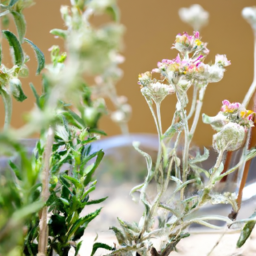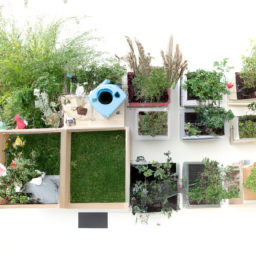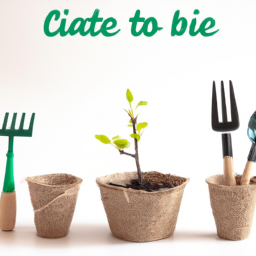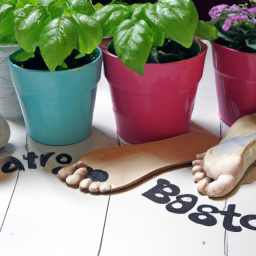
Green Roof Gardens: Enhancing Urban Spaces Sustainably
Welcome to our blog post where we delve into the fascinating world of green roof gardens and how they are transforming urban spaces sustainably. In today’s rapidly urbanizing world, the concrete jungle seems to be expanding relentlessly, leaving little room for nature to thrive. However, innovative solutions such as green roof gardens are emerging as a sustainable way to bring greenery back into our cities. These elevated gardens not only beautify the urban landscape but also offer numerous environmental benefits. So, let’s explore the concept of green roof gardens and discover how they are revolutionizing our urban spaces in a sustainable manner.
Benefits of Green Roof Gardens in Urban Areas
Introduction
Green roof gardens have become increasingly popular in urban areas as a sustainable solution to enhance the environment and improve the quality of life for city dwellers. These rooftop gardens provide numerous benefits, ranging from environmental to social and economic advantages. In this article, we will explore the various benefits of green roof gardens and how they can contribute to enhancing urban spaces sustainably.
Environmental Benefits
One of the primary advantages of green roof gardens is their positive impact on the environment. These gardens act as natural filters, absorbing pollutants and improving air quality. The vegetation on the rooftops captures dust particles, reduces carbon dioxide levels, and releases oxygen, creating a healthier and cleaner atmosphere in urban areas.
Additionally, green roof gardens mitigate the urban heat island effect, which refers to the increased temperature in cities compared to surrounding rural areas. The plants on these rooftops provide shade and evaporative cooling, reducing the overall temperature and energy consumption in buildings. This helps combat climate change and creates a more comfortable living environment for urban residents.
Furthermore, green roof gardens play a crucial role in stormwater management. The plants and soil on these rooftops absorb rainwater, reducing the burden on stormwater systems and preventing flooding. By retaining and filtering rainwater, green roof gardens contribute to the overall water quality and reduce the strain on urban infrastructure.
Social Benefits
Green roof gardens offer numerous social benefits that enhance the quality of life in urban areas. These rooftop gardens provide a green oasis amidst the concrete jungle, offering a space for relaxation, recreation, and social interaction. They serve as communal areas where residents can gather, engage in activities, and connect with nature.
The presence of green spaces has been proven to have a positive impact on mental health and well-being. Green roof gardens provide a respite from the hustle and bustle of city life, offering a peaceful and calming environment. Spending time in these gardens can reduce stress, improve mood, and promote overall mental well-being.
Moreover, green roof gardens contribute to urban biodiversity by providing habitats for birds, insects, and other wildlife. They create a more balanced ecosystem and support the preservation of local flora and fauna. This biodiversity enhances the overall ecological value of urban areas and promotes a sense of connection with nature among city dwellers.
Economic Benefits
Green roof gardens also offer significant economic benefits for urban areas. Firstly, these gardens improve the energy efficiency of buildings. By providing insulation and reducing heat transfer, green roofs can lower heating and cooling costs, resulting in energy savings for building owners and occupants.
Furthermore, green roof gardens increase the lifespan of rooftops by protecting them from extreme weather conditions and UV radiation. The vegetation and soil act as a natural barrier, preventing roof deterioration and reducing maintenance and replacement costs over time.
In addition, green roof gardens enhance property values in urban areas. The presence of these gardens adds aesthetic appeal and uniqueness to buildings, making them more attractive to potential buyers or tenants. Properties with green roofs often command higher prices and rental rates, providing a return on investment for building owners.
Conclusion
Green roof gardens offer a multitude of benefits for urban areas, ranging from environmental advantages like improved air quality and stormwater management to social benefits such as enhanced well-being and community engagement. Additionally, these gardens provide economic advantages by improving energy efficiency, extending roof lifespan, and increasing property values. By incorporating green roof gardens into urban spaces, we can create more sustainable and livable cities for future generations.

Designing and Implementing Sustainable Green Roof Gardens
Welcome to the world of sustainable green roof gardens! In this guide, we will walk you through the process of designing and implementing your very own green roof garden. Green roofs have gained popularity in urban spaces due to their numerous environmental benefits, including improved air quality, reduced energy consumption, and enhanced biodiversity. So, let’s dive in and explore how you can create your own green oasis sustainably.
1. Assessing Your Roof
The first step in designing a green roof garden is to assess your roof’s suitability. Not all roofs are suitable for green roofs, so it’s important to evaluate a few key factors:
Structural Capacity: Green roofs are heavy, so it’s crucial to ensure that your roof can support the additional weight. Consult a structural engineer to determine the load-bearing capacity of your roof.
Sunlight Exposure: Most plants require sunlight to thrive, so assess the amount of sunlight your roof receives throughout the day. This will help you choose the right plants for your green roof garden.
Access and Safety: Consider how you will access your green roof garden and ensure that safety measures, such as railings or barriers, are in place to prevent accidents.
2. Choosing the Right Plants
Once you have assessed your roof’s suitability, it’s time to choose the right plants for your green roof garden. When selecting plants, keep the following factors in mind:
Climate: Choose plants that are well-suited to your local climate. Native plants are often the best choice as they are adapted to the local environment and require less maintenance.
Drought Tolerance: Green roofs are exposed to direct sunlight and can experience water scarcity. Select plants that are drought-tolerant and can withstand extended periods without water.
Root Depth: Consider the depth of your growing medium and choose plants with shallow root systems to prevent damage to the roof structure.
3. Building the Green Roof
Now that you have assessed your roof and chosen the right plants, it’s time to build your green roof garden. Here are the key steps involved:
1. Roof Preparation: Clean the roof surface and repair any existing leaks or damages. Ensure proper waterproofing and install a root barrier to prevent plant roots from penetrating the roof membrane.
2. Drainage System: Install a drainage layer to allow excess water to drain away from the plants. This prevents waterlogging and helps maintain healthy plant growth.
3. Growing Medium: Add a layer of lightweight, well-draining growing medium to provide a suitable environment for plant roots. The depth of the growing medium will depend on the types of plants you choose.
4. Plant Installation: Carefully plant your chosen vegetation, considering their spacing requirements and growth habits. Ensure proper irrigation and mulching to promote plant establishment.
5. Maintenance: Regularly monitor and maintain your green roof garden. This includes watering, fertilizing, pruning, and removing any weeds or pests. Inspect the roof periodically for any signs of damage or leaks.
Congratulations! You have successfully designed and implemented your sustainable green roof garden. Enjoy the beauty and benefits of your green oasis while contributing to a greener and more sustainable urban environment.

Maintaining and Caring for Green Roof Gardens in Urban Spaces
Introduction
Welcome to the world of green roof gardens! These sustainable urban spaces not only enhance the beauty of our cities but also provide numerous environmental benefits. However, like any garden, green roof gardens require regular maintenance and care to thrive. In this article, we will guide you through the essential steps to ensure the health and longevity of your green roof garden.
1. Regular Inspections
The first step in maintaining a green roof garden is to conduct regular inspections. These inspections help you identify any potential issues early on and take appropriate action. Start by checking the overall health of the plants, looking for signs of disease or pests. Inspect the drainage system to ensure it is functioning properly and not clogged. Check for any damaged or loose components, such as loose soil or broken irrigation lines.
During your inspection, also keep an eye out for any weeds that may have found their way onto your green roof garden. Weeds can compete with your plants for nutrients and water, so it’s important to remove them promptly.
Make it a habit to inspect your green roof garden at least once a month, adjusting the frequency based on the specific needs of your plants and the climate in your area.
2. Watering
Proper watering is crucial for the health of your green roof garden. The frequency and amount of water needed will depend on various factors, including the type of plants, weather conditions, and the depth of the growing medium.
One way to determine if your plants need water is to check the moisture level of the soil. Insert your finger about an inch into the soil. If it feels dry, it’s time to water. However, be cautious not to overwater, as excessive moisture can lead to root rot and other problems.
Consider installing an irrigation system to ensure consistent watering. This can be as simple as a drip irrigation system or a more advanced automated system that adjusts watering based on weather conditions.
3. Fertilization
Fertilizing your green roof garden is essential to provide the necessary nutrients for healthy plant growth. However, it’s important to choose the right type of fertilizer and apply it properly.
Opt for organic fertilizers whenever possible, as they are more environmentally friendly and promote long-term soil health. Slow-release fertilizers are particularly beneficial for green roof gardens, as they provide a steady supply of nutrients over an extended period.
When applying fertilizer, follow the instructions on the package carefully. Avoid over-fertilizing, as this can lead to nutrient runoff and harm the surrounding environment.
Conclusion
Maintaining and caring for green roof gardens in urban spaces is a rewarding and sustainable endeavor. By conducting regular inspections, watering appropriately, and providing the right nutrients, you can ensure the longevity and health of your green roof garden. Remember, each green roof garden is unique, so it’s important to adapt these guidelines to suit your specific plants and environmental conditions. Enjoy the beauty and benefits of your green oasis in the heart of the city!
In Summary
Green roof gardens are becoming increasingly popular as a sustainable way to enhance urban spaces. These gardens, also known as rooftop gardens, are designed to create a green oasis amidst the concrete jungle. By utilizing the unused space on rooftops, they not only provide a visually appealing environment but also offer numerous environmental benefits.
One of the key advantages of green roof gardens is their ability to reduce the heat island effect in urban areas. The plants and soil on the rooftop act as natural insulators, absorbing and deflecting the sun’s heat, thus reducing the overall temperature of the building and the surrounding area. This helps to combat the urban heat island effect, where cities become significantly hotter than the surrounding rural areas due to the concentration of buildings and asphalt. Additionally, green roofs help to improve air quality by filtering pollutants and capturing dust particles, making the air cleaner and healthier for the residents of the city.
Top FAQs:
Q1: What is a green roof garden?
A1: A green roof garden, also known as a living roof or eco-roof, is a sustainable and environmentally friendly concept that involves planting vegetation on the roof of a building. It transforms an otherwise unused space into a thriving garden that offers numerous benefits.
Q2: How do green roof gardens enhance urban spaces?
A2: Green roof gardens enhance urban spaces by bringing nature back into the concrete jungle. They provide a peaceful and aesthetically pleasing environment, improving the overall quality of life for city dwellers. These gardens also help mitigate the heat island effect, reduce stormwater runoff, and enhance biodiversity.
Q3: What are the benefits of green roof gardens?
A3: Green roof gardens offer a wide range of benefits. They improve air quality by absorbing carbon dioxide and releasing oxygen. They also act as natural insulation, reducing energy consumption and lowering heating and cooling costs. Additionally, these gardens provide habitat for birds, bees, and other pollinators, promoting urban biodiversity.
Q4: Can anyone have a green roof garden?
A4: In most cases, anyone can have a green roof garden. However, it depends on various factors such as the structural capacity of the building, local regulations, and the expertise required for installation and maintenance. It’s important to consult with professionals who specialize in green roof gardens to determine the feasibility and suitability for your specific situation.
Q5: How can I start a green roof garden?
A5: Starting a green roof garden requires careful planning and consideration. Here are some general steps to get you started:
1. Assess the structural capacity of your building to ensure it can support the additional weight.
2. Consult with a green roof specialist or landscape architect to design the garden and choose appropriate plants.
3. Obtain any necessary permits or approvals from local authorities.
4. Hire professionals experienced in green roof installation to ensure proper implementation.
5. Regularly maintain the garden by watering, fertilizing, and removing weeds.
Remember, each location and building is unique, so it’s essential to seek professional guidance throughout the process.

Alex Turner is a sustainable gardening advocate and the founder of an acclaimed indoor gardening blog. With a focus on eco-friendly practices and urban sustainability, Alex combines his background in environmental studies with his love for plants to educate readers on mindful indoor gardening. His work highlights the importance of nurturing both plants and the planet.


